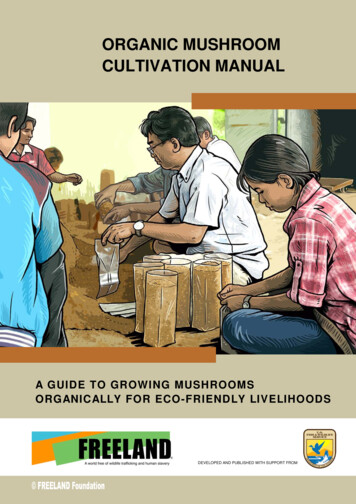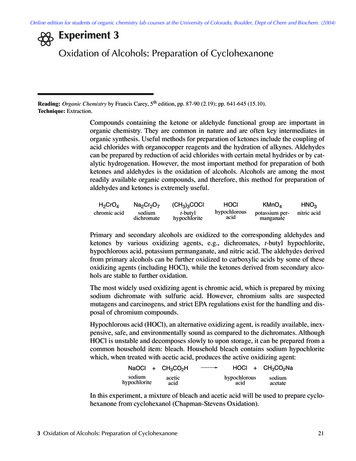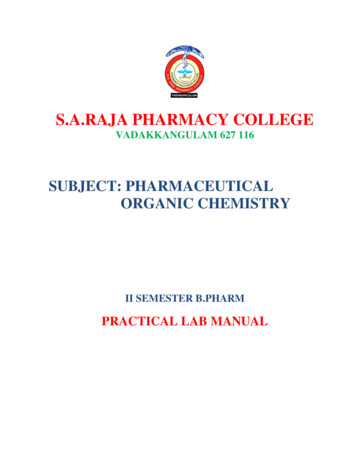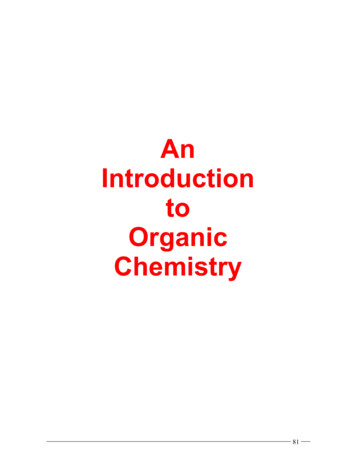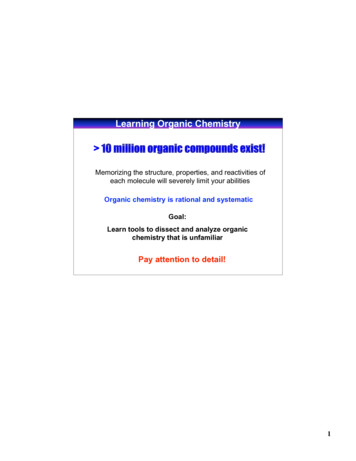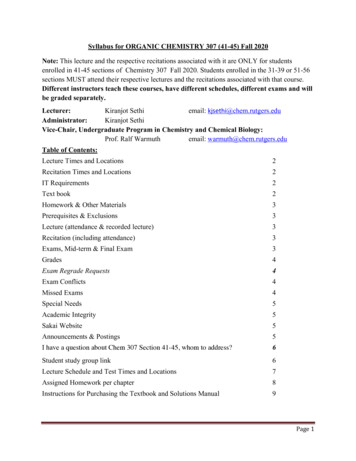
Transcription
Chem 350-Online JasperseSyllabus1ORGANIC CHEMISTRY I: CHEMISTRY 350 SYLLABUS (Course ID 000492)Online Class - Spring 2022Dr. Craig P. Jasperseweb: c-chemistry-i-350-fall-spring/or ne.htm (classic)Zoom-Room: https://minnstate.zoom.us/j/8827046226Office: Hagen 407JTelephone:(218) 477-2230e-mail: mailto:jasperse@mnstate.eduOffice Hours:M-T-W-F 9-10:30; M-T-W-H-F 1-2. But much afternoon time is available, too .)Syllabus ContentsSummary: Required Text and Materials Summary of Test Topics Grading QuizzesSchedule: Detailed Topic BreakdownWhich Lectures, Practice-Sets, and Practice Test Videos Go with Each TestTesting Options: Zoom, Using Proctor Local to You, or On-Site at MSUMPage2How Can I Get off to a Good Start? Go through the Following Steps5-61. Flexible Course Pacing and Test Scheduling.2. Setting fixed-schedule to protect against procrastinationSome Suggested Possible Schedules 16-week, 12-week, 9-week, etc.7Copy of “Full” Detailed Schedule/Topics as Used in Equivalent “Face-to-Face” Class11 On-Line Lectures. Video-playing diagnostic. How to Download videos as mp4 files, so you don’t need internet connection1. Which Videos go with Which Tests?3. In-Class Notes2. Why you need to finish the videos well 4. Practice tests, Answers, and Videos.before taking the tests.5. Practice Problems/Practice Sets.Sapling On-Line Homework and How to Register1. Study Strategy 2. “ChemSurvival” Videos3. Class E-Mail ListBook Homework Problems.1. Course Help, Office Hours, Communication2. Classroom Response Plan3. ACS Certified4. Academic Honesty5. About Online-Organic-Chemistry Website6. University PoliciesGetting Registered for MSUM and Course, for non-MSUM Distance Students (and Pay)1. Academic and Student Support Services 2. Technical Skills Expected.3. Technical Support1. Accessibility and Disability Services2. Technology Privacy Policies and Accessibility StatementsCourse Summary1. Overall Course Objectives/Outcomes/Competencies2. Instructional Materials.3. Activities/Practice4. Self-Assessment5. Graded Assessment (Required Work).Individual Test 1, 2, 3, and 4 Expected Skills/Objectives/Outcomes/Competencies12Safety & Procedural Information348-101313,141515,16171819202122232627
2ORGANIC CHEMISTRY I: CHEMISTRY 350-ONLINE SYLLABUSSPRING 2022Dr. Craig P. Jasperseweb: c-chemistry-i-350-fall-spring/or ne.htm (classic)Zoom-Room: https://minnstate.zoom.us/j/8827046226Office: Hagen 407JTelephone:(218) 477-2230e-mail: mailto:jasperse@mnstate.eduOffice Hours:M-T-W-F 9-10:30; M-T-W-H-F 1-2. But much afternoon time is available, too .)Course Description: CHEM 350. Organic Chemistry I. 3 Credits. Introduction to the classification, structure,reactions, and reaction mechanisms of carbon compounds. Prerequisites: CHEM 210 (General Chemistry II).Required Text and Materials:1) Text: "Organic Chemistry", 8th edition OR 7th edition OR 6th edition, by Wade (Note: if you have a differentWade edition, or a version of Carey’s Organic Chemistry as used at NDSU, contact me in order to use what you have.)Note: These aren’t the newest versions, so you can buy used ones cheap on-line. See website for Amazon links to cheapcopies: and%20Materials.pdf2) Solutions Manual: "Solutions Manual, Organic Chemistry." Get the edition that matches the textbook edition youbuy. (In other words, if you have 8th edition test, make sure you get the 8th edition solution manual, etc.)3) Online “Achieve” homework. https://achieve.macmillanlearning.com/startTest ScheduleTest #1 (100 pts)Test #2* (100 pts)Test #3 (100 pts)Test #4 (100 pts)Final Exam (150 pts)Complete by May 11Grading Summary:TestsFinal examTake-Home QuizzesOn-Line HomeworkCh. 1 Introduction and ReviewCh. 2 Structure and Properties of Organic MoleculesCh. 3 Structure and Stereochemistry of AlkanesCh. 4 The Study of Chemical ReactionsCh. 5 StereochemistryCh. 6 Alkyl Halides: Nucleophilic Substitution and EliminationCh. 7 Structure and Synthesis of AlkenesCh. 8 Reactions of AlkenesCh. 15 Conjugated Systems and Orbital SymmetryCh. 16 Aromatic CompoundsCh. 17 Reactions of Aromatic CompoundsComprehensive Final Exam400 points (4 x 100)150 points (1 x 150)27 points73 points (prorated)Tentative letter gradesA/A 90%B-/B/B 80%C-/C/C 70%D-/D/D 58%The instructor may lower but will not raise the numbers required for a letter grade.Final Exam:Tests 1-4.The final exam will be cumulative, covering all of the same material tested previously onJasperse e-organic-chemistry-i-350-fall-spring/Or “classic” 0online.htm Both websites sites provide links to:Notes for use in classRecorded LecturesSaplingQuizzesPractice TestsJasperse ScheduleTextbook InfoMiscellaneousOn-line “Sapling” homework Problems: You will be required to buy access to an on-line homeworksystem (see later page in syllabus for details.) These problems will be computer-graded, will give yousome practice and sometimes tips, and will help to keep you from procrastinating.
3Schedule: Which Lecture Videos and Practice-Set Videos Go with Each TestOrganic Chemistry 1, Jasperse, Wade Version 8 (43 class days, 39 lectures)Other version of Wade, or other Other-Textbooks.htmlVideo TopicReadingAssignmentTEST 1 LECTURES12345678910Intro. Why Carbon is Special, Normal bonding, Lewis Structures in Organic1. Normal Bonding. 2. Formal Charge and Abnormal Bonding. 3. Electronegativity1. Structural formulas: Full, Condensed, and Skeletal 2. Resonance Structures1. Mechanism/Arrow-pushing. 2. Acid-Base Chemistry. 3. Anion Stability Patterns.VSEPR 3D Shape. Drawing 3D; Hybridization; Pi bonds; Isomers,Polarity IMF, Boiling Points, Solubility. Catchup. Functional GroupsFunctional Groups. Alkane NomenclatureAlkane Nomenclature. Newman Projections; Torsional and Steric Strain; CycloalkanesCyclohexane Chairs, Cis-and-Trans, Structural IsomersCatchup/Practice. First 38 minutes of video 10.Additional Practice Sets/Videos: Mechanism Practice; Acid-Base Practice; 3D-Drawing Practice;Newman Projection Practice; Cyclohexane PracticeTest 1 Practice Tests: V1, V2, V3, V4101112Radical Halogenation; Mechanism; Radicals; Bond Energies; Reaction Energies. Last 12 minutes of Video.Rate Laws, Transition States, Stability-Reactivity PrinciplesRadical Brominations. Major product, mechanism, structure isomers. Stability patterns for carbon radicals,cations, and anions.Chiral vs achiral, Enantiomers, Recognizing/Drawing Mirror Images.Chiral Carbons; Attachment Priorities; R/S Designation; Drawing Chiral MoleculesRacemic MIxtures, Optical Activity, Meso, Molecules with More than One Chiral CenterDrawing Stereoisomers, Meso Compounds. Alkyl Halides Intro, Classification, and NamingThe Sn2 Substitution Reaction.The Sn1 Substitution Reaction.SN1 REactions in More Depth. Elimination ReactionsE1 and E2 Reactions in More Depth; Recognizing Which Reaction Will Occur. Catchup, Practice.Catchup/Practice. First ? minutes of video 21.Additional Practice Sets/Videos: Br2/hv Products/Mechanisms Practice; Introductory MechanismPractice; Extra Stereochemistry Practice; Extra Mechanisms Product Prediction PracticeTest 2 Practice Tests: V1, V2, V3, V41.1-1.61.7, 3.93.9-3.15TEST 2 7-6.21CatchupTEST 3 LECTURES212223242526272829Intro to alkenes, Elements of Unsaturation (EU), Last ? minutes of video 21Hydrogenation Isomers; Alkene Nomenclature. E/Z; Heats of HydrogenationAlkene Synthesis. From RX. Bulky Bases. From Alcohols via Acid-Catalyzed E1. Mechanism Recognition.Addition reactions to Alkenes. Addition of HBr; Acid-Catalyzed HOH Addn.Acid-Catalyzed HOH Addn; Indirect HOH Addn (Hydroboration-Oxidation). Synthesis Designanti-Mark HBr and HOH addition; Synthesis Design, H2 addn; Br2 addnBr2 and BrOH additions and mechanisms; epoxidationEpoxidation, Dihydroxylation, Ozonolysis. Stereospecific Alkene Reactions. Synthetic Design.Catchup/Practice. First ? minutes of video 29.Additional Practice Sets/Videos: Test 3 Extra Practice 1; Test 3 Extra Mechanisms Practice; Test 3 AlkeneReactions Practice; Test 3 Extra Synthesis Practice (6 pages)Test 3 Practice Tests: V1, V2, V3, V42930313233Conjugation, Molecular Orbitals, Dienes, Allylic Cations, Additions to Dienes. Last ? minutes of video.More allylic cations/radicals/conjugation and Applications;Diels-Alder Reaction; AromaticityAromaticity; Huckel's Rule and Complex AromaticsComplex Aromaticity, Application, Nomenclature(Skip "endo rule" section in 15.11A, p. 684; Skip 15.12,13)Electrophilic Aromatic Substitution: Intro, Mech, Kinetic EffectsReactions in Detail: Halogenation, Nitration, Sulfonation, Alkylation, AcylationCatchup; Addition to Disubstituted Benzenes; Synthetic ApplicationsSide Chain Reactions; Retrosynthesis; Synthetic Applications; PracticeReview for Test 4More allylic cations/radicals/conjugation and Applications;Additional Practice Sets/Videos: HBr Addn to Dienes NBS Allylic Bromination; Conjugation-AllylicDiels-Alder Practice; Aromatic Substitution Mechanisms (Products Provided); Aromatic SubstitutionProduct Prediction/Mechanisms/Synthesis DesignTest 4 Practice Tests: V1, V2, V3, V4Final Exam, -108.8-8.98.12-8.16CatchupTEST 4 LECTURES34353637383915.1-615.7-1115.11, 16.1-216.1-716.8-11, 1317.1,6-817.2-5,10,1117.9, practice17.14--15.7-11Final Exam
4Testing Options: Via Zoom, Using a Proctor Local to You, or On-Site at MSUM1. Testing: The nature of organic chemistry requires drawing/illustrating complex structures forchemicals, and illustrating electron movements during reaction mechanisms. As such it is notconducive to multiple-choice or short-answer questions. Written tests can be taken either via Zoom,on-site at MSUM, or by using a proctor local to where you live.2. Flexible Test Scheduling: There are not fixed tests dates. To some degree, you can makearrangements to take the tests (within limits) at your own schedule.o You could individualize your schedule. Gone for a long weekend for a family vacation or awedding or national guard? Having surgery and missing a week? You could work ahead asneeded to ensure the ability to master all of the material.3. Testing Optionsa. Proctored Testing via ZOOM: You make arrangements with me; I send you the test; and I monitoryou online via ZOOM. This is especially practical during COVID-19 restrictions or quarantine. Youwouldn’t need to leave your home.a. My Zoom-room link: https://minnstate.zoom.us/j/8827046226b. Email me to suggest a couple of time slots that could work for you, and I’ll try to find one thatcan fit.c. Most weekdays other than Thursday will work.d. Sometimes by arrangement I’m willing to do testing on Saturdays at 9am central time, or on aweekday evening at 7pm.b. Testing live at MSUM: Hagen 405/407J. I have a really nice conference room right next to my office. Contact me regarding times that you might like. I will always protect M/W/F at 1pm, but feel free to suggest/request other times that workwell for you.c.Live-Proctored Testing, local to you: You would make the arrangements. Arrange to haveyour tests proctored, typically at a local hospital, college, library, church or high school, etc.,or with some other responsible individual.a. For taking proctored tests, YOU will need to find/arrange the proctor; arrange schedulingwith that proctor; email me the email, name, phone number, and job (ortesting center or library or whatever) for your proctor; and email me awebsite for the organization that the proctor is a part of. (For example, ifyour church pastor is going to proctor your exam, I’d like to look him up to make sure he andthe church really exist, before calling him to confirm! J)b. For proctored tests, I will email tests to the proctor who will print them. After a test is donethe proctor will scan and email me the answers and destroy the printed copy.c. Most colleges have proctoring services.d. Many public libraries are willing to provide proctoring services4. Testing time is 90 minutes.1) Tests are structured so that a well-prepared student should be able to complete a test in50 minutes or less. But by allowing 90 minutes, that gives extra time to work onproblems that you might get stuck on; it provides time to check your work; it providesmore space for students who don’t work fast; and it provides enough cushion so that youcan just focus on your test without being distracted by worrying about the clock.2) If you do take proctored tests, you will want to arrange for a 90-minute time block.5. PROCTORED TESTS WILL NOT BE RETURNED. Given the flexible test-scheduling, I willnot be able to send you copies of your graded tests. Local students can see graded test in my office.This is one aspect of online organic that can’t mirror regular class. But no practical way I can getaround it. Sorry. L
5How can I get off to a good start? Go through the following steps. Explore the website(s): c-chemistry-i-350-fall-spring/Find the links for each of the following, and in each case open and browse a little bit:a. Lecture Videos:b. Practice Tests:c. Syllabus:d. Textbook and Materials:e. Class Notes:f. Quizzes:g. Online Homework (“Sapling”):h. Test 1 (and 2 and 3 and 4) materials:i. General Information about how this online organic chemistry course will workLinks for all of the above, and more, are available on the main website1. Before the class begins, you’ll want to have done the following:a. Register for the class For distance students or NDSU students (basically students who aren’t already MSUMstudents): nDistanceStudents.pdf Jasperse video explaining: stration-OVerview/1 upct9ngbb. Order books (used textbook and solutions manual). Amazon links: Materials.pdfc. Sign up for Sapling Online Homework: http://www2.saplinglearning.comd. Print Syllabus: online.pdfe. Print Class Notes (double-side print, but best to do full-size): hem350-online.pdf Buy a big 3-ring binder, and 3-hole punch notes so you can keep them all organized.f. Bookmark the main ne-organic-chemistry-i-350-fall-spring/oMaybe set the play speed at x1.5, or fast forward through online Face-with-Voice-Personal-Intro/1 sasxj5r1g. View the video in which I talk through the syllabus and the course.o Access from main website, under "Organic Chemistry I - Test 1: Introduction & Alkanes”h. View Jasperse personal introduction video (with face showing! J):2. Preparing for Test 1a. Print To-Do Checklist for Test 1: 50Test1.pdfb. Review Skills/Competencies for Test 1: 50-Test1.pdfc. Go through the lectures with the printed notes e-organic-chemistry-i-350-fall-spring/ After each lecture, review the materialDo lots of Practice/Homework Problems Many sample practice problems integrated into the lectures Required Sapling online homework Practice sets. (Both main website and lectures website link to same sets.) Recommended book homework problems as time permitsDo the required quizzes (there are two for Test 1)Do the practice testsArrange proctored testing unless you can test at MSUM.
63. Basics of how the course will work: The course will help you master the content through the use of recorded video lectures anddetailed notes; through lots of different practice problems in varying formats; and throughmultiple practice tests that are similar to the real tests. You will have scheduling flexibility in how fast you move and when you schedule your tests. Tests can be taken via a proctor or at MSUM. The grade will be 80-85% based on test performance, the rest on required homework andquizzes.
7Dates, Flexible Schedules: Go-At-Your-Own-Pace “Asynchronous”.1. FLEXIBILITY. You can schedule your own test dates (so long as you finish all by May 11, 2022)2. The “Official” semester start date is January 11, 2022 You can start earlier, much earlier, if you want3. Semester Completion date: May 11, 2022.a. You can finish early, and you can start early (or late), but you MUST FINISH BY MAY 11b. MSUM academic calendar, for Spring and Spring classes: https://www.mnstate.edu/academiccalendars.aspx4. YOU CAN START EARLY, AND/OR FINISH EARLY. (But must finish by May 11 deadline.) I will try to have all course materials ready/online at least a month (usually many months) early Since lectures and learning materials are online, you don’t need to wait for the official universitysemester start dates to actually start. You could start sooner.5. “GO AT YOUR OWN PACE”/ASYNCHRONOUS. Self-schedule your tests. As long as you complete all of the tests by the end of the semester (May 11), test dates are otherwiseunfixed/undefined. Some suggested planning schedules are shown on the following pages. Online Homework assignments likewise have no fixed due dates, other than end-of-semester For distance students testing with proctor, you can pretty much set up testing times with your proctorfor whatever time fits your mutual schedules. For those testing on-campus, you can schedule to take any test on any Monday, Tuesday, Wednesdayor Friday that fits your schedule and your readiness. I will offer regular M/T/W/F testing at 9 am.Monday, Tuesday and Friday afternoons are also usually available, by arrangement. You can adjust on the fly, to some degree. For example, suppose you were planning to take Test 1 onMonday, Jan 22, but you realized that if you could study more and take it on Tuesday or Wednesdayor Friday, you could do much better. That would be OK. (Of course, it’s all too easy to keep“moving tests back” only to run out of time, so be disciplined )6. For each individual test, plan to finish the regular lectures a week (or most of a week) prior to when youactually intend to test, so you have time to practice. Practice makes perfect! Organic has LOTS of information. Tests will require that you know how to USE the info. So, doing a lot of practice problems, practice sets, and practice tests is crucial for test preparation.7. “IT’S EASY TO PROCRASTINATE AND FALL BEHIND. TRY TO SET UP AN AGGRESSIVESCHEDULE FOR YOURSELF SO THAT YOU GET DONE EARLY. THAT WAY IF YOU DOHAVE SOME SETBACKS, YOU’LL HAVE SOME CUSHION TIME. If you schedule to take the full 16 weeks, that will leave you no cushion in case job or other classes orpersonal issues create a scheduling crisis and leave you unable to prepare adequately. If you schedule to finish early, that provides some “extra” weeks in case you need them. Or, if youfinish Organic early, then it won’t be competing for limited time late in the semester when you’reperhaps cramming to finish papers, projects and final exams in other classes.8. PROCTORED TESTS WILL NOT BE RETURNED. Given the flexible test-scheduling, I will not beable to send you copies of your graded tests. Sorry. L But if you test on campus or via zoom, I willnormally be able to grade the test right away and enable you to see where you lost points.9. The following pages have some info to help with scheduling.
8Some Suggested Possible Schedules: Test Scheduling Possibilities (Overview):Using 50-minute MSUM Kaltura organic-chemistry-i-350-fallspring/Test 1Test 2Test 3Test 4Lectures 1-10 (under “Organic Chemistry I - Test 1 ” pulldown) Lectures 10b-21 (under “Organic Chemistry I - Test 2 ” pulldown) Lectures 22-29 (under “Organic Chemistry I - Test 3 ” pulldown) Lectures 30-39 (under “Organic Chemistry I - Test 4 ” pulldown)16-week: (see next page for more detailed suggested schedule) Four weeks per typical test For typical test, Weeks 1-3: Go through all lecture videos, Sapling online homework, and some of the extrapractice sets. For most tests, this will be about four lecture videos per week. Week 4: Study a lot; go through all the practice sets; complete any quizzes or incomplete Sapling; reviewlecture video discussion on topics that don't make sense; do all the practice tests. Then take the actual test. One week left to study for final and actually take the final Test 3 doesn’t have as many lectures and shouldn’t take as long. Test 4 is very hard. It takes longer to understand and master the content.12-week: (see two pages later for more detailed suggested schedule) Three weeks per typical test Weeks 1-2: Go through all lecture videos, Sapling online homework, and some of the extra practice sets. Formost tests, this will be about five lecture videos per week. Week 3: Study a lot; go through all the practice sets; complete any quizzes or incomplete Sapling; reviewlecture video discussion on topics that don't make sense; do all the practice tests. Then take the actual test. This could leave variable time to study for the final. Why aim for 12-week schedule?o This could give time to finish early, so you could focus on other end-of-semester responsibilities.o This leaves cushion, in case one of the tests you struggle, or have other time-pressure crises.o This could finish before or immediately following Easter.o Finishing within 12 weeks could be helpful if you started late for whatever reason. Test 3 doesn’t have as many lectures and shouldn’t take as long. Test 4 is very hard. It takes longer to understand and master the content.10-week: (see two pages later for more detailed suggested schedule) Two-and-a-half weeks per test (17 days) Days 1-11: Go through all lecture videos, Sapling online homework, and extra practice sets. Days 12-16: Study a lot; go through all the practice sets; complete any quizzes or incomplete Sapling; reviewlecture video discussion on topics that don't make sense; do all the practice tests. Then take the actual test. Spend an 11th week studying for and then taking final. Why aim for 9-week schedule?o Just get it done really fast?o Maybe you started late for whatever reason?o During last summer, I had 160 students who completed course in 8 weeks or less (some in 6 weeks),so it’s certainly possible. Test 4 is very hard. It takes longer to understand and master the content.8-week: (see two pages later for more detailed suggested schedule) Two weeks per test 8 days: Go through all lecture videos, Sapling online homework, and some extra practice sets. Days 9-13: Study a lot; go through all the practice sets; complete any quizzes or incomplete or incompleteSapling; review lecture video discussion on topics that don't make sense; do all the practice tests. Day 14: Take the actual test. Spend a 9th week studying for and then taking final. Test 4 is very hard. It takes longer to understand and master the content.
9Some Suggested Possible SchedulesPossible/Suggested 16-week Schedule (you can personalize it, and start it earlier or later): This approximates what students in a full-semester face-to-face class would do; 3-4 lectures per week.Using 50-minute MSUM Kaltura organic-chemistry-i-350-fall-spring/Test 1Mon 2/7Test 2Mon 3/7Test 3Mon 4/11Test 4Mon 5/2 Lectures 1-10Finish lectures/Sapling by Monday, Jan 31Digest/Practice/Integrate Tuesday -till-testLectures 10b-22Finish lectures/Sapling by Monday, Feb 28Digest/Practice/Integrate Tuesday -till-testLectures 22-29Finish lectures/Sapling by Monday, April 4Digest/Practice/Integrate Tuesday -till-testLectures 30-39Finish lectures/Sapling by Monday, April 25Digest/Practice/Integrate Tuesday -till-testStudy like crazy for a week! It’s hard.FinalMon 5/9Notes on the 16-week schedule: On this schedule you should routinely be going through test lectures in three weeks ( 4 lectures per week), thengiving yourself most of a week to catch up, study, review, do lots of practice problems, practice sets, andpractice tests prior to actually taking the tests. You could move faster if you wished. A week is included between test 4 and the cumulative final. The final must be completed by May 11th. These dates assume you want to match with the regular class schedule. But, probably you don’t.o You’d do well to finish sooner.o That way, if you’re taking other classes that have end-of-semester requirements and final exams, yourtime for this class wouldn’t be competing with your time for those.o Many of you may wish to start way early, well before Jan 11. The more you accomplish before otherspring activities/class kick in, the better.o Wouldn’t it be nice to complete before Easter? Or, perhaps before the end of April, before final examsin other courses are pressing in? Test 4 is very hard. It takes longer to understand and master the content.Schedule Flexibility and the Possibility of Customizing Your Schedule to Your Own Circumstances: As long as you complete all of the tests by the end of the semester (May 11), test dates are otherwiseunfixed/undefined. You could start way early (including as early as November!) and finish way early as well (including as earlyas February or March) if you wish. For those testing on-campus, you can schedule to take any test on any Monday, Tuesday, Wednesday orFriday that fits your schedule and your readiness. I will offer regular Monday/Tueday/Wednesday/Fridaytesting at 9am, and will be able to test at many other times upon request and arrangement.o You can make case-by-case arrangements with me to test on other days/times. For distance students testing with proctor, you can pretty much set up testing times with your proctor forwhatever time or day fits your mutual schedules. In my listed schedules, I’m usually listing Mondays orFridays. But if you are testing using a proctor, you can arrange any day of the week that works for you andproctor. You can adjust on the fly, to some degree. For example, suppose you were planning to take Test 1 on Friday,Feb 4, but you realized that if you could study for a couple more days and take it on Monday or Tuesday, youcould do much better. That would be OK. (Of course, it’s all too easy to keep “moving tests back” only torun out of time, so be disciplined )
10Possible/Suggested 12-week Schedule (you can personalize it, and start it earlier or later): This should involve about 5 lectures per week.Using 50-minute MSUM Kaltura organic-chemistry-i-350-fall-spring/Test 1Mon 1/31Test 2Mon 2/21Test 3Mon 3/21Test 4Mon 4/11FinalMon 4/18 Lectures 1-10aFinish lectures/Sapling by Monday, Jan 24Digest/Practice/Integrate Tuesday-till-testLectures 10b-22Finish lectures/Sapling by Monday, Feb 14Digest/Practice/Integrate Tuesday -till-testLectures 22-29Finish lectures/Sapling by Monday, Mar 14Digest/Practice/Integrate Tuesday -till-testLectures 30-39Finish lectures/Sapling by Monday, April 4Digest/Practice/Integrate Tuesday -till-testStudy like crazy for the final! It’s hard.Possible/Suggested 10-week Schedule (you can personalize it, and start it earlier or later): This should involve about 6 lectures per week.Using 50-minute MSUM Kaltura organic-chemistry-i-350-fall-spring/Test 1Fri 1/28Test 2Fri 2/11Test 3Fri 3/4Test 4Fri 3/25FinalFri 4/1 Lectures 1-10aFinish lectures/Sapling by Monday, 1/24Digest/Practice/Integrate Tuesday-till-testLectures 10b-22Finish lectures/Sapling by Monday, 2/7Digest/Practice/Integrate Saturday-till-testLectures 22-29Finish lectures/Sapling by Monday, 2/28Digest/Practice/Integrate Tuesday-till-testLectures 30-39Finish lectures/Sapling by Monday, 3/21Digest/Practice/Integrate Tuesday-till-testStudy like crazy for a week! It’s hard.Possible/Suggested 8-week Schedule (you can personalize it, and start it earlier or later): This should involve an average of at least one video lecture per day, weekends included.Using 50-minute MSUM Kaltura organic-chemistry-i-350-fall-spring/Test 1Mon 1/24Test 2Mon 2/7Test 3Mon 2/28Test 4Mon 3/14FinalMon 3/21 Lectures 1-10aFinish lectures/Sapling by Thursday, 1/20Digest/Practice/Integrate Friday-till-testLectures 10b-22Finish lectures/Sapling by Thursday, 2/3Digest/Practice/Integrate Friday-till-testLectures 22-29Finish lectures/Sapling by Thursday, 2/24Digest/Practice/Integrate Friday-till-testLectures 30-39Finish lectures/Sapling by Thursday, 3/10Digest/Practice/Integrate Friday-till-testStudy like crazy for a week! It’s hard.
11Copy of “Full” Schedule as Used by a Regular “Face-to-Face” Class.Chemistry 350, Jasperse, Spring 2022 Wade 7 (43 class days, 39 14-JanTopicIntro. Why Carbon is Special, Normal bonding, Lewis Struc
1) Text: "Organic Chemistry", 8th edition OR 7th Note: if you have edition OR 6th edition, by Wade (a different Wade edition, or a version .)of Carey’s Organic Chemistry


